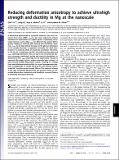| dc.contributor.author | Qi, Liang | |
| dc.contributor.author | Li, Ju | |
| dc.contributor.author | Yu, Qian | |
| dc.contributor.author | Mishra, Raja K. | |
| dc.contributor.author | Minor, Andrew M. | |
| dc.date.accessioned | 2014-03-24T18:10:06Z | |
| dc.date.available | 2014-03-24T18:10:06Z | |
| dc.date.issued | 2013-08 | |
| dc.date.submitted | 2013-04 | |
| dc.identifier.issn | 0027-8424 | |
| dc.identifier.issn | 1091-6490 | |
| dc.identifier.uri | http://hdl.handle.net/1721.1/85911 | |
| dc.description.abstract | In mechanical deformation of crystalline materials, the critical resolved shear stress (CRSS; τ[subscript CRSS]) is the stress required to initiate movement of dislocations on a specific plane. In plastically anisotropic materials, such as Mg, τ[subscript CRSS] for different slip systems differs greatly, leading to relatively poor ductility and formability. However, τ[subscript CRSS] for all slip systems increases as the physical dimension of the sample decreases to approach eventually the ideal shear stresses of a material, which are much less anisotropic. Therefore, as the size of a sample gets smaller, the yield stress increases and τ[subscript CRSS] anisotropy decreases. Here, we use in situ transmission electron microscopy mechanical testing and atomistic simulations to demonstrate that τ[subscript CRSS] anisotropy can be significantly reduced in nanoscale Mg single crystals, where extremely high stresses (~2 GPa) activate multiple deformation modes, resulting in a change from basal slip-dominated plasticity to a more homogeneous plasticity. Consequently, an abrupt and dramatic size-induced “brittle-to-ductile” transition occurs around 100 nm. This nanoscale change in the CRSS anisotropy demonstrates the powerful effect of size-related deformation mechanisms and should be a general feature in plastically anisotropic materials. | en_US |
| dc.description.sponsorship | National Science Foundation (U.S.) (Grant DMR-1120901) | en_US |
| dc.description.sponsorship | National Science Foundation (U.S.) (Grant DMR-1008104) | en_US |
| dc.description.sponsorship | General Motors Research and Development Center | en_US |
| dc.language.iso | en_US | |
| dc.publisher | National Academy of Sciences (U.S.) | en_US |
| dc.relation.isversionof | http://dx.doi.org/10.1073/pnas.1306371110 | en_US |
| dc.rights | Article is made available in accordance with the publisher's policy and may be subject to US copyright law. Please refer to the publisher's site for terms of use. | en_US |
| dc.source | National Academy of Science (U.S.) | en_US |
| dc.title | Reducing deformation anisotropy to achieve ultrahigh strength and ductility in Mg at the nanoscale | en_US |
| dc.type | Article | en_US |
| dc.identifier.citation | Yu, Q., L. Qi, R. K. Mishra, J. Li, and A. M. Minor. “Reducing Deformation Anisotropy to Achieve Ultrahigh Strength and Ductility in Mg at the Nanoscale.” Proceedings of the National Academy of Sciences 110, no. 33 (August 13, 2013): 13289–13293. | en_US |
| dc.contributor.department | Massachusetts Institute of Technology. Department of Materials Science and Engineering | en_US |
| dc.contributor.department | Massachusetts Institute of Technology. Department of Nuclear Science and Engineering | en_US |
| dc.contributor.mitauthor | Qi, Liang | en_US |
| dc.contributor.mitauthor | Li, Ju | en_US |
| dc.relation.journal | Proceedings of the National Academy of Sciences | en_US |
| dc.eprint.version | Final published version | en_US |
| dc.type.uri | http://purl.org/eprint/type/JournalArticle | en_US |
| eprint.status | http://purl.org/eprint/status/PeerReviewed | en_US |
| dspace.orderedauthors | Yu, Q.; Qi, L.; Mishra, R. K.; Li, J.; Minor, A. M. | en_US |
| dc.identifier.orcid | https://orcid.org/0000-0002-0201-9333 | |
| dc.identifier.orcid | https://orcid.org/0000-0002-7841-8058 | |
| mit.license | PUBLISHER_POLICY | en_US |
| mit.metadata.status | Complete | |
